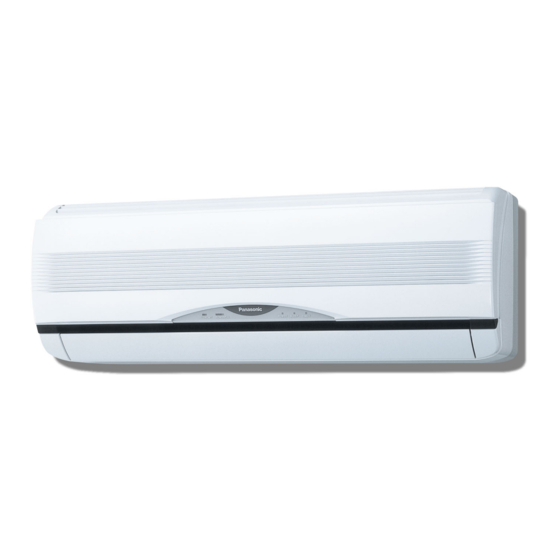
Panasonic CS-V7BKP Service Manual
Hide thumbs
Also See for CS-V7BKP:
- Operating instructions manual (14 pages) ,
- Operating instructions manual (94 pages)
Advertisement
Quick Links
Subject : Improvement of Contents
Please file and use this supplement manual together with the service manual for Model No. CS-V7BKP/CU-
V7BKP5, CS-V9BKP/CU-V9BKP5, CS-V12BKP/CU-V12BKP5, Order No. MAC0110055C2.
CONTENTS
1 Features (Page: 2)
2 Product Specifications (Page: 10)
3 2-way, 3-way Valve (Pages: 40~52)
1 Features (Page: 2)
(Additional)
• Environmental Friendly
− R410A, which does not contain chlorine, is used as its refrigerant, so there is no danger of damage to the ozone layer
in Stratosphere.
2 Product Specifications (Page: 10)
(Correction)
Compressor
Rated
3 2-way, 3-way Valve (Pages: 40~52)
(Deleted 2-way, 3-way valve information due to explanation of gas charging can not use for new refrigerant R410A).
Page
Unit
Output
W
CS-V7BKP CU-V7BKP5
CS-V9BKP CU-V9BKP5
CS-V12BKP CU-V12BKP5
1
4 Installation and Servicing Air Conditioner Using R410A
1
5 Technical Data (Pages: 60~61)
1
CS-V12BKP
—
© 2002 Matsushita Air-Conditioning Corp. Sdn. Bhd.
(183914D). All rights reserved. Unauthorized copying
and distribution is a violation of law.
Order No. MAC0203006S2
Room Air Conditioner
CU-V12BKP5
830
Page
2
13
Advertisement

Summary of Contents for Panasonic CS-V7BKP
- Page 1 Room Air Conditioner CS-V7BKP CU-V7BKP5 CS-V9BKP CU-V9BKP5 CS-V12BKP CU-V12BKP5 Subject : Improvement of Contents Please file and use this supplement manual together with the service manual for Model No. CS-V7BKP/CU- V7BKP5, CS-V9BKP/CU-V9BKP5, CS-V12BKP/CU-V12BKP5, Order No. MAC0110055C2. CONTENTS Page Page 1 Features (Page: 2)
- Page 2 4 Installation and Servicing Air Conditioner Using R410A (Additional new content) 4.1. OUTLINE 4.1.1. About R410A Refrigerant 1. Converting air conditioners to R410A Since it was declared in1974 that chlorofluorocarbons (CFC), hydro chlorofluorocarbons (HCFC) and other substances pose a destructive danger to the ozone layer in the earth´s upper stratosphere (20 to 40 km above the earth), measures have been taken around the world to prevent this destruction.
-
Page 3: Tool For Installing / Servicing Refrigerant Piping
d. R410A refrigerating machine oil Conventionally, mineral oil or a synthetic oil such as alkylbenzene has been used for R22 refrigerating machine oil. Because of the poor compatibility between R410A and conventional oils like mineral oil, however, there is a tendency for the refrigerating machine oil to collect in the refrigerating cycle. - Page 4 4.2.2. R410A Tools 1. Cooper tube gauge for clearance adjustment (used when flaring with the conventional flaring tool (clutch type)) • This gauge makes it easy to set the clearance for the copper tube to 1.0-1.5 mm from the clamp bar of the flaring tool.
- Page 5 5. Charging hose • The pressure resistance of the charging hose has been raised to match the higher pressure of R410A. The hose material has also been changed to suit HFC use, and the size of the fitting has been changed to match the manifold ports.
- Page 6 8. Electronic scale for refrigerant charging • Because of the high pressure and fast vaporizing speed of R410A, the refrigerant cannot be held in a liquid phase inside the charging cylinder when charging is done using the charging cylinder method, causing bubbles to form in the measurement scale glass and making it difficult to see the reading.
-
Page 7: Refrigerant Piping Work
4.3. REFRIGERANT PIPING WORK 4.3.1. Piping Materials It is recommended that you use copper and copper alloy jointless pipes with a maximum oil adherence of 40 mg/10m. Do not used pipes that are crushed, deformed, or discolored (especially the inside surface). If these inferior pipes are used, impurities may clog the expansion valves or capillaries. - Page 8 Table 11 R410A flaring dimensions Nominal Outside Wall thickness A (mm) diameter diameter (mm) R410A flaring Conventional flaring tool (mm) tool, clutch type Clutch type Wing-nut type 6.35 0 - 0.5 1.0 - 1.5 1.5 - 2.0 9.52 0 - 0.5 1.0 - 1.5 1.5 - 2.0 12.70...
-
Page 9: Installation, Transferring, Servicing
b. Copper pipes Use only copper pipes with the thickness given in table 10, and with minimal impurities. Because the surface of the pipe is exposed, you should take special care, and also take measures such as marking the pipes to make sure they are easily distinguished from other piping materials, to prevent mistaken use. - Page 10 4.4.2. Transferring (Using New Refrigerant Piping) 1. Removing the unit a. Collecting the refrigerant into the outdoor unit by pumping down The refrigerant can be collected into the outdoor unit (pumping down) by pressing the TEST RUN button, even when the temperature of the room is low.
- Page 11 5. Set the refrigerant cylinder onto the electronic scale, then correct the hose the cylinder and to the connection port for the electronic scale. (1)(2) Precaution: Be sure to set up the cylinder for liquid charging. If you use a cylinder equipped with a siphon tube, you can charge the liquid without having to turn the cylinder around 6.
- Page 12 <Brazing Method for Preventing Oxidation> 1. Attach a reducing valve to the nitrogen gas cylinder. 2. Attach a reducing valve to the nitrogen gas cylinder. 3. Apply a seal onto the clearance between the piping and inserted pipe for the nitrogen gas in order to prevent the nitrogen gas from flowing backward.
- Page 13 5 Technical Data (Pages: 60~61)
- Page 14 [MACC] Printed in Malaysia...














Need help?
Do you have a question about the CS-V7BKP and is the answer not in the manual?
Questions and answers